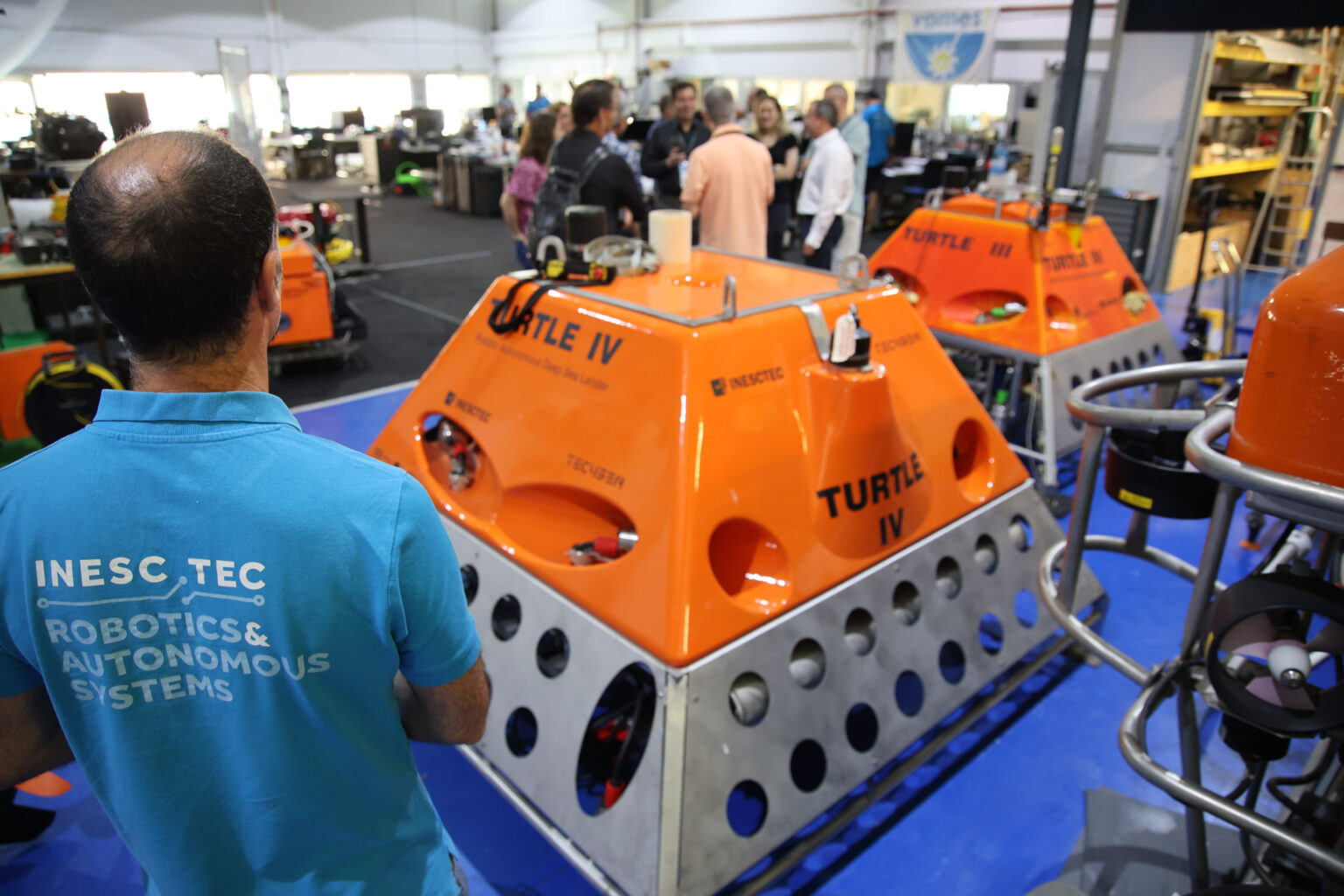Robotics and Autonomous Systems Laboratory
The Robotics and Autonomous Systems Laboratory focuses on the development of innovative robotic solutions for complex and dynamic environments. Its work spans data gathering, inspection, mapping, surveillance, and intervention missions—both in surface and underwater domains.
Core research areas include:
- Autonomous navigation
- Long-term deployments
- Sensing, mapping, and intervention
- Multi-platform robotic operations
Within INESCTEC.OCEAN, this lab plays a central role in Marine Robotics, backed by over 30 years of expertise and a fleet of more than 20 autonomous and remotely operated vehicles. The lab supports advanced R&D+I in air, surface, and underwater systems, including infrastructure and tooling for Ocean Engineering.
Key equipment includes:
- 1,000 m² of indoor space atISEP Campus
- Marine robotics test tank (5 m depth, 6 m width, 10 m length – 3,000 m³ total volume)
- Two hyperbaric chambers simulating depths up to 7,500 m (750 bar) and 4,000 m (400 bar)
- Additional test tank at FEUP Campus (4.5 m x 4.5 m x 2 m)
Microfabrication Laboratory
This laboratory supports both traditional top-down and advanced laser-based microfabrication techniques for developing integrated photonic and sensing devices. It plays a key role in producing resilient, high-precision components for marine sensing applications within the Ocean Data domain.
Main research areas:
- 3D inscription of waveguides and photonic devices
- Bragg grating fabrication using point-by-point methods
- Microfluidic and optofluidic device fabrication
- Micromachining of advanced materials
Key equipment includes:
- Femtosecond Satsuma laser with harmonic generation module
- 3D laser direct writing system for planar substrates
- Laser writing system for Bragg grating (Aerotech ABL1000 stage)
- Integrated optical characterisation station (MDE881 Elliot Gold Series)
Located at FCUP (Faculty of Sciences, University of Porto), this lab supports smart sensor development for underwater applications, including real-time ocean data collection and sharing.
Nanofabrication Laboratory
Specialising in nanostructure development, this lab focuses on thin film deposition via RF magnetron sputtering and other advanced nanofabrication processes. It supports the full development cycle of optical sensors for marine monitoring—integrating fabrication, characterisation, and system optimisation.
Main research areas:
- Multilayer Plasmonic structures
- Optical filters based on dielectric materials
- One-dimensional Photonic crystals (1D PhCs)
- Support for lithography techniques
- Integration with optical fibre technologies
Key equipment includes:
- High-vacuum film deposition chambers
- Multi-material deposition systems for alloy synthesis
- Controlled-atmosphere chambers for thermal/plasma treatment
- Spectroscopic ellipsometer for thin-film characterisation
The Nanofabrication Lab is located at FCUP and contributes to theOcean Data domain of our Centre of Excellence’s research, enabling the creation of high-performance optical sensors for real-time environmental analysis and marine data acquisition.
Spectral Imaging Laboratory
The Spectral Imaging Laboratory develops advanced multimodal spectral systems that enable precise optical measurement and imaging—particularly where traditional microscopy is insufficient. With applications in marine, industrial, and biological contexts, the lab focuses on achieving high spatial resolution and non-invasive data capture.
Main research areas:
- Chemical data visualisation using spectral imaging
- Real-time integration with digital twin systems
- Environmental applications for monitoring, pollution control, and water quality
- Multiplatform deployment (satellites, drones, AUVs, landers)
Key capabilities include:
- AI-powered tools grounded in physical sensing principles
- Multimodal sensing algorithms for cross-technique data integration
- Industry-ready software and hardware systems for spectral imaging
Key equipment includes:
- Laser-Induced Breakdown Spectroscopy (LIBS) systems
- Raman spectroscopy instruments
- Hyperspectral imaging platforms
- X-ray fluorescence equipment
Located at FCUP, this lab plays a strategic role in INESCTEC.OCEAN’s data processing activities, contributing to the acquisition, interpretation, and dissemination of high-resolution ocean and environmental data.
Advanced Sensors Laboratory
This laboratory focuses on the development of advanced sensor technologies for real-time monitoring of physical, biological, and chemical parameters in diverse marine settings. It supports both distributed sensing and optoelectronic systems for in situ analysis.
Main research areas:
Distributed Sensing and Structural Monitoring
- Development of optic fibre-based sensing technologies
- Monitoring of physical parameters in diverse environments
- Application of distributed sensing solutions for new and existing structures
- Advanced data processing and analysis techniques
- Numerical simulation methodologies for system modelling and validation
Optoelectronic and Bio-Chemical Detection
- Real-time chemical and biological detection
- Bio-chemical sensing integrated with electronic platforms
- Techniques for chemical manipulation and sample preparation
- Electrochemical analysis for enhanced target detection and quantification
Key equipment includes:
- Distributed Acoustic Sensing (DAS) systems
- Polarimetric measurement equipment
- Nanofiber fabrication platforms
- High-power laser systems (Raman sources, EDFAs, and 140W pump lasers)
- Electrospinning equipment
- Chemical manipulation facilities
- Sensor’s functionalisation setups
- 3D Printers for rapid prototyping
- Wide-band and high-resolution spectrometers
- Fourier Transform Infrared (FTIR) systems
- Gas Chromatography systems, MS and TDC detectors
Located at FCUP, the Advanced Sensors Lab supports INESCTEC.OCEAN’s research on Ocean Data topics, delivering innovation in resilient, high-accuracy marine sensor platforms.
Communications Laboratory (CommsLab)
Established in 2006, the CommsLab supports the experimental testing of next-generation marine communications and sensing systems. It enables controlled validation of prototypes before deployment in operational environments.
Main research areas:
- Optical, RF, and acoustic communications for marine environments
- Simulation-to-field validation of data and sensing systems
- Cross-domain platforms for wireless connectivity
Key equipment includes:
- Optical and electronic test equipment for R&D in electronics
- Optical and RF communications nodes
- Low frequency characterisation equipment and a 3D printing machine
- Electrically large anechoic chamber (1.2 m x 0.6 m x 0.6 m) designed for evaluating antennas from 67 GHz to 115 GHz
- Low Earth Orbit (LEO) Satellite communications gateway
- Software Defined Radio (SDR) hardware and companion computing nodes
- Robotic platforms (e.g., drones, balloons, and a robot dog) for on-demand communications
- Acoustic modems;
- Small sized water tank for characterization and validation of optical, acoustic and RF underwater communications solutions.
Located at INESC TEC’s headquarters on the Campus of the Faculty of Engineering, University of Porto, CommsLab contributes directly to INESCTEC.OCEAN’s data communications and ocean monitoring capabilities.
Spectral Imaging Laboratory
InfoLab focuses on the management, retrieval, and preservation of digital information, supporting research in data systems architecture and long-term knowledge management. With expertise in informatics and information science, the lab plays a key role in structuring and preserving scientific data in marine research contexts.
Main research areas:
- Web and text mining
- Semantic web and ontologies
- Research data management and digital preservation
- Repository design and metadata integration
Key outputs:
- Dendro: An open-source platform that helps researchers describe, structure, and export datasets using Linked Open Data.
- ANT: A semantic search engine for academic content, integrated with the University of Porto’s SIGARRA information system.
Based at the Department of Informatics Engineering at FEUP, InfoLab supports INESCTEC.OCEAN’s activities related to the Ocean Data domain, contributing to robust data workflows, metadata structuring, and long-term digital preservation strategies.
Spectral Imaging Laboratory
The Software Engineering Laboratory develops methods, tools, and frameworks for designing, testing, and maintaining software systems. It ensures that digital platforms supporting marine operations are reliable, efficient, and user-focused.
Main research areas:
- Software testing and quality assurance
- Agile methodologies and knowledge management
- Software process improvement and requirement evolution
- Serious games for education and user engagement
Located in the Department of Informatics Engineering at FEUP, the lab supports all INESCTEC.OCEAN research domains by providing software engineering capacity for control systems, simulation platforms, data interfaces, and educational tools.
Spectral Imaging Laboratory
The CG&VE Lab explores immersive technologies, simulation environments, and visualisation systems to support human–machine interaction, digital twinning, and data visual representation. It is instrumental in the development of user-centred interfaces for complex marine systems.
Main research areas:
- Multisensory virtual environments and perceptual modelling
- Game-based learning, e-learning platforms, and digital storytelling
- Procedural content generation and computer-generated holography
- Image rendering, simulation, and AR/VR interaction design
- Geospatial visualisation and multimodal interfaces
Key infrastructure:
- Multisensory experimental room
- Immersive visualisation in VR (3D and 2D), including projection systems, HDR screens, HMDs, and Oculus EyeTracker
- Equipment for olfactory stimulation in VR, including butanol sensitive kit, Scentroid SM-100, and a vacuum chamber
- Equipment for multimodal interaction, such as Microsoft Kinect v. 2.0, Myo Gesture Control Armband, and Leap Motion hand tracking
- Equipment for augmented reality (AR), including Google Glass
- Tracking and measurement of psychophysiological signals, with tools such as Optitrack, SMI eye tracking (Monitor), SMI eye tracking glasses (SMI-ETG) for smart recorder, Emotiv Epoc+ Premium, Nexus X, Emotif, and VitalJacket.
- Exploration in VR, including an omnidirectional treadmill and a Virtusphere
- BQ 3D Printer
Located across FEUP and UTAD (University of Trás-os-Montes and Alto Douro) campuses, this lab contributes to INESCTEC.OCEAN’s efforts in digital twin development, ocean interface visualisation, and remote system control.




